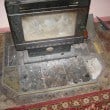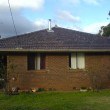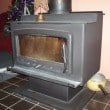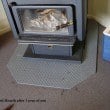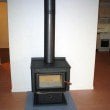B8.5 Active heating of houses
An active heating system uses energy to heat the house. Some examples of active heating systems include wood heaters, gas heaters, electric fan heaters, radiators and reverse cycle air conditioners.
Active heating systems can consume large amounts of energy and money. Standard plug-in electrical heaters, typical in many communities, can use over 100kW of energy a day to heat an average size house. Wood heaters can consume up to 28 kilograms of wood a day. A well designed house will reduce the need for active heating and an efficient heating system can also reduce running costs to residents.
To conserve heating energy, houses can be sealed to prevent draughts. With no air exchange, houses can quickly become stuffy and a lack of fresh air entering the house can cause problems for people with asthma and may contribute to the spread of respiratory disease. Gas heaters without a flue can produce harmful gases inside the house. In Australia, government regulations prevent the use of gas heaters in bedrooms.
Survey data show that relatively few houses were subject to cold conditions, with only 413 houses recording an ambient temperature of less than 15ºC at time of survey. There were improvements in house performance in cold conditions since 2013, with only 6% of houses colder inside compared to outside (+9%).
Surveys occur during daylight/work hours and the coldest temperatures would generally be recorded at night or very early in the morning.
Design and Specification
Ensure
- B8.5.1.
the house has been designed and built or upgraded for cold conditions
- B8.5.2.
the rooms to be heated can be sealed against cold draughts.
Consider
- installing efficient slow combustion wood heaters where fire wood is available and constructing a small covered area for the storage of firewood
- venting the fire place to improve the efficiency of the fire
- providing built-in gas heaters with a flue where gas is readily available and affordable
- if using electric heaters, providing built-in ceramic heaters or electric panel heaters or energy efficient heating systems in the living areas and bedrooms
- in very cold climates, using in-slab heating systems
- locating the heater near surfaces with high thermal mass such as concrete slab floors and stone or masonry walls to store excess heat and re-radiate it when the heater has been turned off
- installing convection ducting or mechanical systems such as heat shifting fans to distribute heat from the heated area to other rooms in the house
- installing low volume air-exchange fans to draw some fresh air into the room.
Real world examples of Solutions
- B8.5.1.
Quality control
- heaters are supplied and installed according to the manufacturers requirements and according to building regulations (gas heaters will require a certificate from a licensed gas fitter)

- COMPLETED DESIGN & SPECIFICATION
DURING CONSTRUCTION
AT HANDOVER
FINAL COMPLETION
TRADE TEST
- COMPLETED DESIGN & SPECIFICATION
- wood heaters are located the minimum required distance from walls and flammable materials and are placed on a non-flammable hearth

- DURING CONSTRUCTION
AT HANDOVER
FINAL COMPLETION
- DURING CONSTRUCTION
- vents through the floor, wall and roof for wood and gas heaters are sealed against vermin and flashed to prevent water penetration.

- DURING CONSTRUCTION
AT HANDOVER
FINAL COMPLETION
- DURING CONSTRUCTION
- heaters are supplied and installed according to the manufacturers requirements and according to building regulations (gas heaters will require a certificate from a licensed gas fitter)
Maintenance
As part of cyclical maintenance, check that:
- heaters (electric, gas, wood) are working efficiently and safely

- Plumber, Housing Management, Gas Plumber, Wood Heater Specialist
- 12 Months
- the doors on wood heaters close and seal properly

- Local Maintenance Team, Wood Heater Specialist
- 12 Months
- there are no cracks in the glass face of gas or wood heaters

- Local Maintenance Team, Wood Heater Specialist
- 12 Months
- non-flammable materials around a wood heater are intact

- Carpenter, Local Maintenance Team, Wood Heater Specialist
- 12 Months
- flues or chimneys are cleaned regularly.

- Housing Management, Wood Heater Specialist
- 12 Months
- consider developing timber wood lots using waste water and use the harvested timber for fire places

- Housing Management
- 24 Months
- monitor the temperature in houses and the cost of heating to identify more energy efficient housing designs and heating systems.

- Housing Management
- 24 Months
- heaters (electric, gas, wood) are working efficiently and safely
Standard And References
National Construction Code 2022 Volume 2 - H7D5 (whole)
National Construction Code 2022 Volume 2 - H6V3 Verification of building envelope sealing,and especially 2 (b) and (c).
AS1691 – 1985 Domestic oil fired appliances – Installation – Amdt 1 Sept 1985
AS/NZS2918 – 2018 Domestic solid fuel burning appliances – Installation
AS/NZS1200 – 2000 Pressure equipment
Renew Getting off gas toolkit, 2023
NSW Health Unflued gas heaters 2022, https://www.health.nsw.gov.au/environment/factsheets/Pages/unflued-gas-heaters.aspx
Woolcock Institute of Medical Research, THE HEALTH IMPACTS OF USING GAS HEATERS AND APPLIANCES AT HOME
Australian Council of Building Design Professionals, BDP Environment, Royal Australian Institute of Architects.
Building Code of Australia, Part 2.3.3 Heating appliances; Part 3.7.3 Heating appliances; Part 3.12.3.1 Chimneys and flues; Part 3.12.5 Services
Lane, A. House warming, Bush Tech #16, Centre for Appropriate Technology, Alice Springs
Pholeros, P. & South Australian Aboriginal Housing Unit 1998, Temperature Control and Health, pp. 1-4.
Hollo, N 1997, Warm house cool house: inspirational designs for low-energy housing, Choice Books, Marrickville, New South Wales.
Pholeros, P 1997, Energy and Water Use Required for Health in Housing on the Anangu Pitjantjatjara Lands North West of South Australia, for UPK Nganampa Health Council Inc., Alice Springs, pp. 9-10.

